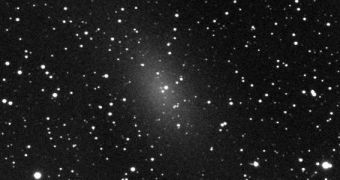A group of astronomers from the Massachusetts Institute of Technology (MIT) in Cambridge, led by expert Anna Frebel, announces the discovery of an extremely old galaxy close to the Milky Way. The object may be one of the first galaxies to emerge in the Universe and, as such, may provide a window into a time when the Cosmos was just a small fraction of its current age.
This estimate is based on an in-depth analysis of heavy chemical elements inside stars present in the Segue 1 dwarf spheroidal galaxy. This measure, known as metallicity, can be used to reconstruct the history of stars. This process is based on our current understanding of how heavy elements are produced inside stars, through nuclear fusion.
When the first stars appeared, they fused hydrogen isotopes such as deuterium and tritium into helium. When these objects exploded as massive supernovae, the helium was spread through space, eventually making its way into a stellar nursery that gave birth to new stars. The second generation of stars fused hydrogen and helium into heavier elements, including silicon, carbon, and oxygen.
The process has been repeating itself ever since, leading to increasingly heavier chemical elements being synthesized at the core of stars. By analyzing the metallicity of each star, researchers can form a rough opinion on when the object developed. The Stars in Segue 1 are extremely metal-poor, implying that they are very old, Nature News reports.
In fact, the MIT-led investigation has determined that the dwarf galaxy – which lies around 75,000 light-years away, in the Leo constellation – most likely stopped evolving no less than 13 billion years ago. Taking into account the fact that the Universe is 13.75 billion years old, this means that the object, also known as a globular cluster, was fully formed less than 1 billion years after the Big Bang.
If these findings are confirmed, then Segue 1 could be used as a measuring stick for revealing the conditions that permeated the Cosmos in its infancy. Further analysis of the dwarf galaxy may also reveal how some of the most massive galaxies in the Universe came to be. Finding ways to study these questions is a very complicated process, so identifying Segue 1 is a stroke of luck for astronomers.
For this study, investigators analyzed the metallicity of six bright stars in Segue 1 via the Magellan Telescopes, at Las Campanas Observatory in Chile and the Keck Observatory in Hawaii. Results appear on the preprint server arXiv and they have also been accepted for publication in an upcoming issue of the esteemed Astrophysical Journal.
The team discovered only minute traces of heavy chemicals such as iron in these stars, suggesting that the dwarf galaxy is the least chemically-evolved galaxy ever discovered in space. “Segue 1 is so ridiculously metal-poor that we suspect at least a couple of the stars are direct descendants of the first stars ever to blow up in the Universe,” adds Evan Kirby.
The expert, who holds an appointment with the University of California in Irvine (UCI), is the coauthor of the new investigation. “Segue 1 is the only example that we know of now that was never enriched by these low-mass stars, meaning it formed stars really quickly, in the blink of an eye. If it had formed stars long enough those low-mass stars would have to contribute,” he concludes.

 14 DAY TRIAL //
14 DAY TRIAL //